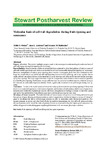Molecular basis of cell wall degradation during fruit ripening and senescence

View/
Date
2005Author
Owino, Willis O
Ambuko, Jane L
Mathooko, Francis M
Metadata
Show full item recordAbstract
Purpose of review: This review highlights progress made in the recent past in understanding the molecular basis of
cell wall changes during fruit ripening and senescence.
Recent findings: Gene expression studies in several fruit have continued to show that isoforms of various classes of
cell wall modifying enzymes and proteins are involved in cell wall disassembly during fruit ripening and senescence.
However, manipulation of various genes encoding these enzymes in transgenic plants have also continued to challenge the central role of any individual cell-wall degrading enzyme in fruit softening, and it now appears that no
single cell-wall modifying enzyme can be identified as being necessary and sufficient for textural changes accompanying fruit ripening. This may suggest that there might be a cooperative action between various enzymes (proteins)
in controlling fruit ripening. Furthermore, it is possible that there are yet to be identified enzymes, which by acting at
low amounts on particularly important chemical bonds, significantly contribute to textural changes during fruit ripening.
Limitations: Tomato is the model system of choice for studying the textural changes during ripeningof fleshy fruit
due to its commercial importance, a rich source of genetic and biochemical information, relative ease of gene transformation and availability of pleiotropic mutants. However, extrapolation of findings in tomato to other fruit species
may not be true and therefore, fruit softening may have to be treated on a case-by-case basis.
Directions of future research: The individual roles of these enzymes and proteins are still being addressed in part
through use of gene silencing techniques (antisense and co-suppression). Another technique is the use of "chimeric"
genes to simultaneously silence several target enzymes in order to manipulate entire biochemical pathways. Proteomics strategies in tomato and other fruit will also be useful in characterising the fruit cell wall proteome to identify novel proteins and to reveal the suites of proteins that are co-expressed during fruit ripening and senescence. An
additional approach in identifying genes regulating fruit texture is the use tomato pleiotropic mutations.
